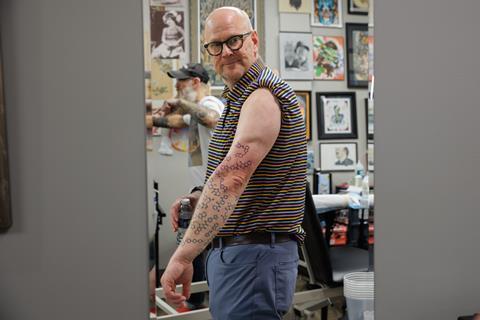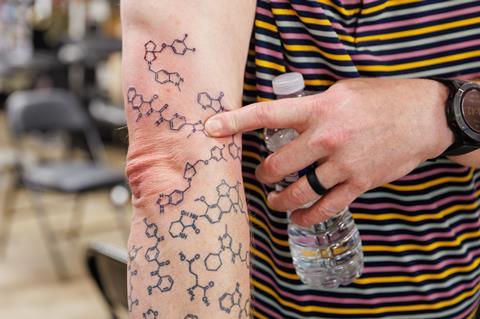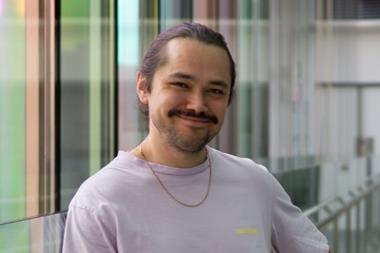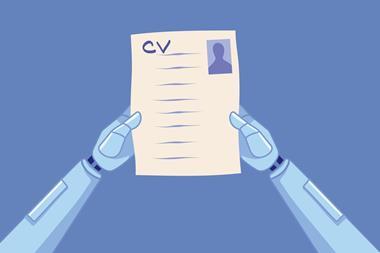University of Nebraska’s drug design centre director is communicating his team’s scientific breakthroughs with tattoos and now has 29 on his arm

Medicinal chemist Corey Hopkins, founding director of the Center for Drug Design and Innovation at the University of Nebraska Medical Center (UNMC) in Omaha, is using his body as a canvas to display some of the most interesting products of his research lab.
It all started about three years ago when he, his wife and two adult daughters decided to get matching family tattoos depicting a four-leaf clover with each of the leaves containing one of their first initials. ‘My wife has looked into our ancestries, and there is a lot of Irish in both of our backgrounds,’ he explains.
Hopkins really dug the tattoo, and the whole experience, and quickly decided that he wanted another one. But he knew that it had to be something really meaningful.
Inspired by some tattoos he had seen representing the molecular structure, or partial structure, of various chemicals, Hopkins recalls wondering: ‘Why don’t I just get tattoos of the stuff that we make in the lab?’
Marking milestones
His first tattoo after the clover was of the neurotransmitter dopamine, as an homage to his team’s work on dopamine receptors. That went on his right arm. It was soon joined by a phosphodiesterase-4 inhibitor compound developed in his lab and already licensed by a company. Then he started getting about four tattoos at a time – always by the same artist who he and his family had originally used, and always on his right arm.
Now Hopkins is up to 29 separate tattoos. They reach above the elbow of his right arm and completely cover the front and back of the lower arm. All done in black ink rather than colour, these tattoos represent milestone discoveries by Hopkins and his research group.
To be immortalised on his arm, a compound needs to successfully progress from test tubes into rodent models. ‘If I’m trying to put on every compound that every student has made, I definitely would not have enough body space,’ he tells Chemistry World. ‘We do drug discovery, so we need to test these molecules for a disease to see if they would work,’ Hopkins continues. ‘So, I decided that if we made a compound and it goes into an animal model of disease, like a pain model, and it works in that model, then that’s the bar needed for it to become a tattoo on my arm.’
Such successes usually also lead to scientific publications, but a couple of Hopkins’ tattoos reflect research that has not yet been published. ‘You could get in trouble if you wanted to patent a molecule and you put it on your arm and it became public, because with patents you can’t have a “public disclosure,”’ he adds. ‘But once we submit the patent then we are free to do whatever we want with that structure – we “own it” and can put it on my arm or in a scientific publication.’

One of Hopkin’s favourites pieces of his skin art is a small molecule that selectively inhibits an ion channel associated with kidney disease, designed and developed with collaborators at Harvard University and published at the end of 2017. ‘We showed that we can reverse chronic kidney disease, which is a very challenging disease,’ he says.
Another of his most beloved tattoos is of an allosteric modulator that appears to successfully interact with a muscarinic receptor that is critical to the nervous system. It was developed by a large team that Hopkins co-led while at Vanderbilt University – where he started his academic career in 2008 – and was pushed into phase one human clinical trials for cognition in Alzheimer’s patients.
That work, published in January, is featured in one of the four tattoos most recently installed on Hopkins’ arm this past spring. Another is of a protein overexpressed in colon cancer tumours, which Hopkins and colleagues are trying to block to hopefully prevent such tumours from growing.
Drawing people in
At least one of the researchers that Hopkins mentors has used his tattoos as a visual aid while presenting the lab’s work. ‘A student of mine was giving a talk in Washington, DC and instead of showing a typical image of the structure, she displayed a picture she took of it on my arm,’ Hopkins recounts. ‘It’s a more interesting, innovative way to communicate the structural information … and it is a way to humanise what we do.’
The tattoos are also a great conversation starter. ‘Wherever I go, someone will usually ask, “What are those?”’ Hopkins says. ‘And it’s not necessarily chemists or scientists asking – it’s regular people who recognise that my tattoos depict chemical structures.’
He hopes to continue adding as tattoos these marks of scientific accomplishments for his students and himself for many years to come. Hopkins wants all these achievements to be visible on his body and says the obvious next place to move when out of room is his left arm.

















No comments yet